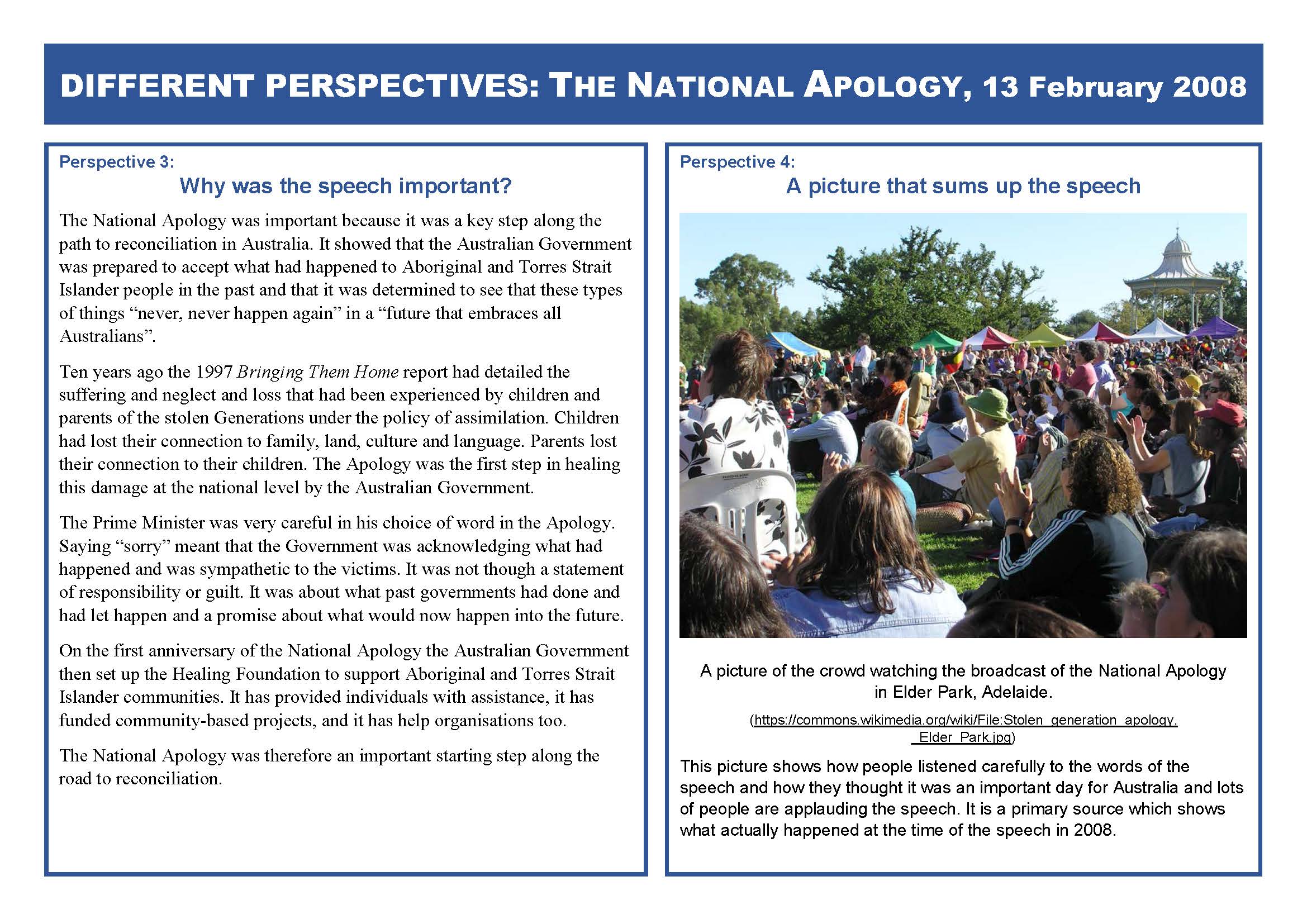- Home
- Resources
- Work samples
- Samples
- Differing perspectives - ABOVE
History
Year 10
Above satisfactory
Differing perspectives
Annotations overview
Creates multiple perspectives to present a balanced view on a past event.
 1
Annotation 1
1
Annotation 1
Describes in detail the context and setting of a historical event 2 Annotation 2
Empathises with the perspective of a person from the past 3 Annotation 3
Uses direct quotation from a source 4 Annotation 4
Paraphrases the speech and uses direct quotation as supporting evidence 5 Annotation 5
Explains in detail the perspective of a person from the past 6 Annotation 6
Recreates themes associated with rights and freedoms using visual and text elements such as recurring words, shape and colour
-
Annotations
-
1
Annotation 1
Describes in detail the context and setting of a historical event -
2
Annotation 2
Empathises with the perspective of a person from the past -
3
Annotation 3
Uses direct quotation from a source -
4
Annotation 4
Paraphrases the speech and uses direct quotation as supporting evidence -
5
Annotation 5
Explains in detail the perspective of a person from the past -
6
Annotation 6
Recreates themes associated with rights and freedoms using visual and text elements such as recurring words, shape and colour
 1
Annotation 1
1
Annotation 1
Describes the impact of the speech 2 Annotation 2
Analyses the importance of the speech based on its historical context 3 Annotation 3
Analyses the importance of the speech based on its setting and audience 4 Annotation 4
Uses direct quotation to support an analysis of the speech 5 Annotation 5
Analyses the content of a visual source
-
Annotations
-
1
Annotation 1
Describes the impact of the speech -
2
Annotation 2
Analyses the importance of the speech based on its historical context -
3
Annotation 3
Analyses the importance of the speech based on its setting and audience -
4
Annotation 4
Uses direct quotation to support an analysis of the speech -
5
Annotation 5
Analyses the content of a visual source
Satisfactory
Differing perspectives
Annotations overview
Creates multiple perspectives to present a balanced view on a past event
 1
Annotation 1
1
Annotation 1
Describes the context of a historical event 2 Annotation 2
Empathises with the perspectives of a person from the past 3 Annotation 3
Uses direct quotation from an acknowledged source 4 Annotation 4
Describes the sequences of events associated with a speech 5 Annotation 5
Reflects on a past event from a particular perspective
-
Annotations
-
1
Annotation 1
Describes the context of a historical event -
2
Annotation 2
Empathises with the perspectives of a person from the past -
3
Annotation 3
Uses direct quotation from an acknowledged source -
4
Annotation 4
Describes the sequences of events associated with a speech -
5
Annotation 5
Reflects on a past event from a particular perspective
 1
Annotation 1
1
Annotation 1
Describes the importance of a speech 2 Annotation 2
Uses direct quotation from a source to support an opinion 3 Annotation 3
Places the speech into its historical context 4 Annotation 4
Analyses the content and purpose of the speech 5 Annotation 5
Describes the content and usefulness of a researched visual source
-
Annotations
-
1
Annotation 1
Describes the importance of a speech -
2
Annotation 2
Uses direct quotation from a source to support an opinion -
3
Annotation 3
Places the speech into its historical context -
4
Annotation 4
Analyses the content and purpose of the speech -
5
Annotation 5
Describes the content and usefulness of a researched visual source
Above satisfactory
Differing perspectives
Annotations overview
Creates multiple perspectives to present a balanced view on a past event.
 1
Annotation 1
1
Annotation 1
Describes in detail the context and setting of a historical event 2 Annotation 2
Empathises with the perspective of a person from the past 3 Annotation 3
Uses direct quotation from a source 4 Annotation 4
Paraphrases the speech and uses direct quotation as supporting evidence 5 Annotation 5
Explains in detail the perspective of a person from the past 6 Annotation 6
Recreates themes associated with rights and freedoms using visual and text elements such as recurring words, shape and colour
-
Annotations
-
1
Annotation 1
Describes in detail the context and setting of a historical event -
2
Annotation 2
Empathises with the perspective of a person from the past -
3
Annotation 3
Uses direct quotation from a source -
4
Annotation 4
Paraphrases the speech and uses direct quotation as supporting evidence -
5
Annotation 5
Explains in detail the perspective of a person from the past -
6
Annotation 6
Recreates themes associated with rights and freedoms using visual and text elements such as recurring words, shape and colour
 1
Annotation 1
1
Annotation 1
Describes the impact of the speech 2 Annotation 2
Analyses the importance of the speech based on its historical context 3 Annotation 3
Analyses the importance of the speech based on its setting and audience 4 Annotation 4
Uses direct quotation to support an analysis of the speech 5 Annotation 5
Analyses the content of a visual source
-
Annotations
-
1
Annotation 1
Describes the impact of the speech -
2
Annotation 2
Analyses the importance of the speech based on its historical context -
3
Annotation 3
Analyses the importance of the speech based on its setting and audience -
4
Annotation 4
Uses direct quotation to support an analysis of the speech -
5
Annotation 5
Analyses the content of a visual source